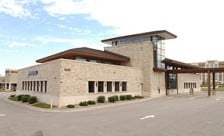Banking on a win
In a bank headquarters that could double as a ski lodge, Jeffrey Rose is looking uphill.
The building is home to First Bank. It is all stone and rich wood with a gas-fed fireplace in the lobby and loft offices. It is warm and friendly. As Rose gives a tour, he comments that it is extremely expensive to operate, and that is part of the hill he is climbing.
Rose is a Valley Junction native, running a bank that was founded in 1901 in West Des Moines’Valley Junction neighborhood.The bank has problems, and Rose knows that plenty of people – banking people, banking regulators, anyone with a nose to the turmoil created in the industry by the collapse of real estate markets and the resulting credit crunch – are watching his performance.
He numbers his good days as three out of five and “three out of five isn’t bad,” he says. He’s also working late nights and long weekends, but those aren’t counted in the equation.
Rose was appointed president and CEO on Sept. 1, replacing Rick Messerschmidt, who moved from that position to chairman of the board. Rose will focus on marketing the bank to its core business customers. He will keep the old and bring in the new.
The change is significant because First Bank has been owned and operated by the Messerschmidt family since 1939, when Roy M. Messerschmidt bought the bank. His son, Roy W., worked at the bank for more than 70 years before announcing his retirement on Sept. 1, leaving his title of chairman to his son, Rick. Rick’s brother, Bill, will be the only member of the family with an office in West Glen Town Center building., where he will preside as chief financial officer.
Rose had been with the bank about 18 months before being named president and CEO. He believes the Messerschmidt family decided some time ago to give him the chance to lead the bank, but were afraid to ask out of fear that he would turn down the job.
“They really were looking for professional management,” Rose said. “I knew the portfolio. I was beginning to know the customers and I grew up here. It just seemed to make a lot of sense.”
He brought some credentials to the job, having worked for Wells Fargo & Co. as a turnaround and workout specialist when the banking giant was buying up other banks.
When Wells bought a bank, Rose was sent in to merge and clean up operations, make personnel changes and reorganize departments. He tidied things up.
He also worked for U.S. Bancorp and JPMorgan Chase & Co., where he was in charge of loan production. That job provided the local son an opportunity to return to the area after working in Los Angeles, Dallas and Houston.
When JPMorgan closed its Greater Des Moines office, Rose and his family decided that they wanted to stay in Greater Des Moines.
He continued to work as a loan consultant and wound up going to work for First Bank as a senior loan officer. His task was to clean up problem loans.
The bank has had more than its share.
According to federal banking statistics, bad loans are eating up First Bank’s balance sheet. In the quarter ending June 30, the bank’s $4.5 million in Tier 1 capital was overshadowed by $5.5 million in property that it had acquired through foreclosures.
A key measure of a bank’s health and ability to survive called the Texas Ratio shows that the bank has been struggling with non-performing loans for the last two years. The Texas Ratio was developed in the 1980s when banks in that state were going through a crisis. It became a fairly accurate indicator of a bank’s ability to survive. It places a bank’s non-performing loans up against its most secure, or Tier 1, capital and loan-loss reserves.
It can also be misleading, said Tom Gronstal, superintendent of the Iowa Division of Banking.
“When you get a Texas Ratio of 40, 50 percent, you know you’ve got some pretty significant issues. It doesn’t mean the bank can’t work out of it, though,” he said.
In the quarter ended June 30, 2008, loans at First Bank that were 90 days or more in arrears stood at slightly more than 32 percent of a combination of its Tier 1 capital and loan-loss reserves. By March 31, 2009, the figure had grown to 101 percent.
The bank’s numbers are improving, but remain high. As of June 30, loans that had not been paid for at least 90 days stood at 52 percent of Tier 1 capital and loan-loss reserves. That number was a 10 percentage point improvement from the previous quarter.
First Bank’s assets had plummeted to $120.7 million as of June 30 from $175 million as of June 30, 2008.
Rose doesn’t shrink from the numbers.
He is shedding assets – the bank sold two branch offices in 2009 – and taking other steps to control costs.
He would like to find a tenant for the east wing of the West Glen headquarters, a law or accounting firm that could take up some slack on the expense side.
“We are improving the capital ratio by shrinking the bank,” Rose said.
The bank is “shrinking” deposits, he said, and investing in securities.
“We divested a large portion of our deposits because we couldn’t use them,” he said.
There are few people looking for loans, he noted, although there has been some uptick from small home builders who take out small loans to build one or two houses, either on contract or on speculation.
First Bank’s Tier 1 capital should be “adequate” by year’s end, Rose said.
In addition, the bank is beginning to show daily operational profits.
Taken all together, “that’s a huge improvement from 1 1/2 years ago,” Rose said.
Rose believes the bank will show a profit by the end of the year.
That is important because he cannot attract additional investment in the bank until he proves that it can turn a profit.
“We have to have a lot of things go right,” Rose said. “But it is somewhat stimulating in that I feel like we can do it.”
Rose noted that First Bank also is up against stiff competition from other Greater Des Moines banks for borrowers with “solid, well-established credit” who are beginning to trickle back into the market in search of loans.
“There are other banks looking for growth, too,” he said with a smile.
Gronstal might have given First Bank a sort of backhanded vote of confidence when he noted that he does not expect any Iowa banks to fail this year.
Overall, Iowa banks remain healthier than others in the nation, helped in large part by the abundance of small community banks dotting the countryside and reaping the benefits of a healthy agricultural economy.
“Most of the trouble is in the acquisition and development of real estate and commercial real estate sectors,” Gronstal said, noting that those characteristics are more typical of urban banks rather than rural lenders.
“Basically, Iowa banks are doing better than the nation, probably because Iowa is doing better than the nation,” he said. “If we’re starting to turn the corner, which I kind of think we are, I think we’re starting to see improvement in the banks.”
Eric Lohmeier, a founding member of the investment banking firm NCP Inc. in Des Moines, cautioned that although the Iowa economy appears stronger and its banks appear better able to come out of the recession, it would be a mistake to think the state’s banking community is immune from the problems facing other banks across the country.
“I’d be hard pressed to say that Iowa isn’t at least one-half the national average in terms of problem institutions,” he said.
The Federal Deposit Insurance Corp. said recently that there are slightly more than 800 institutions on its list of problem banks, that out of more than 8,000 banks in the nation.
Rose, while recognizing that there will be a lot of change at First Bank if it is to prevail, remains optimistic.
“I’m excited about the opportunity; I’m excited about the future,” he said. “If we can do it, it will be a great thing for the bank and it will be a great thing for the city of West Des Moines.
“I’m having fun.”












